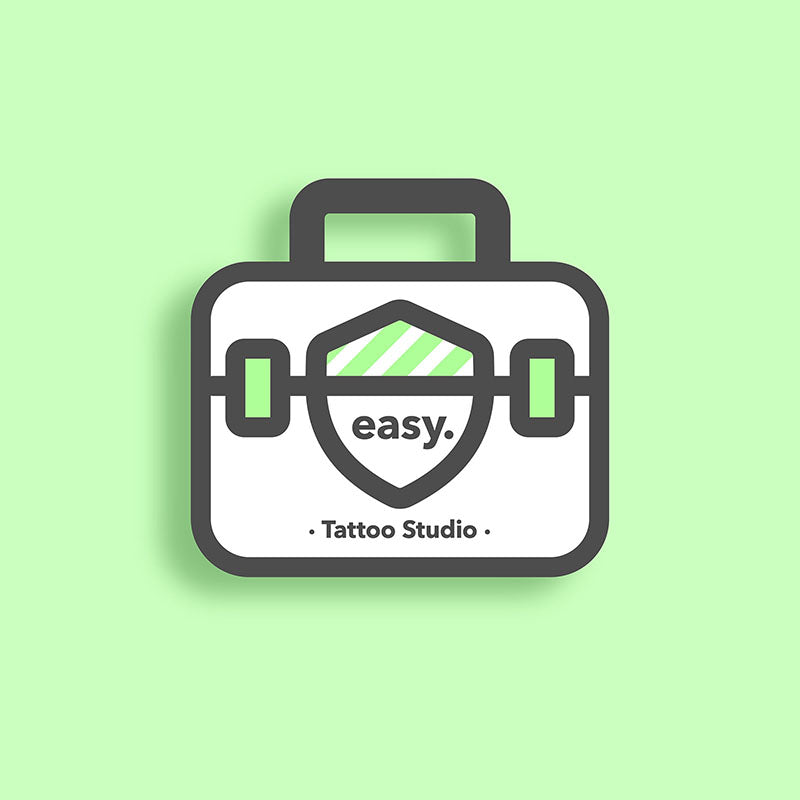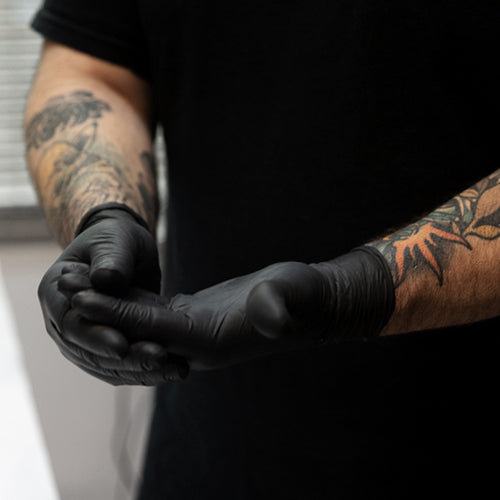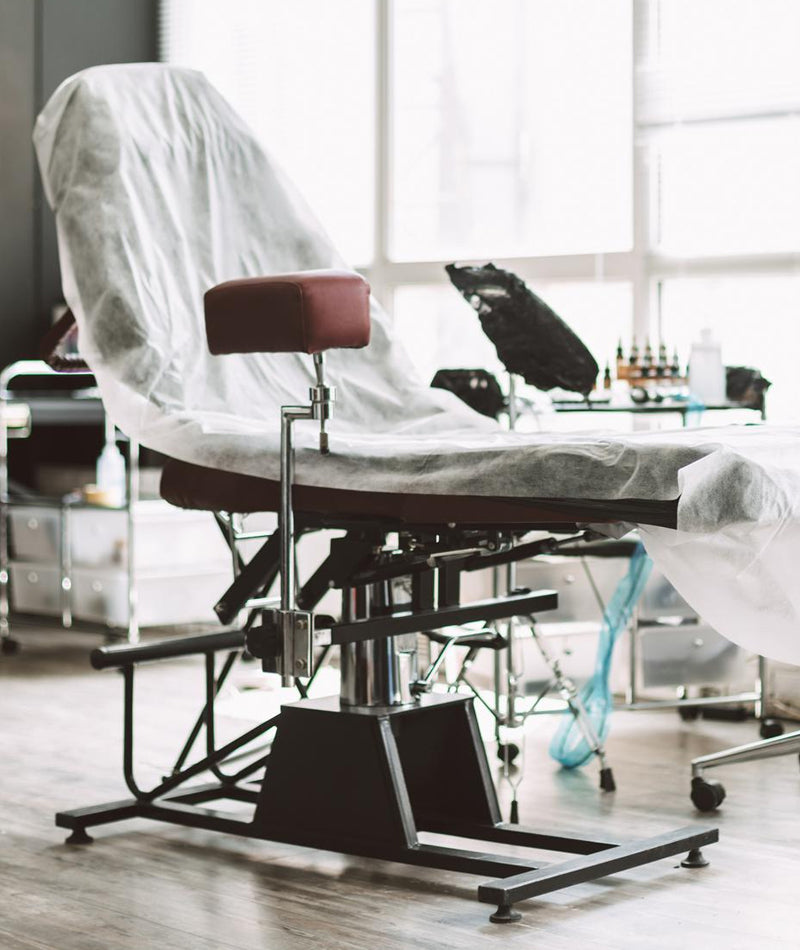
Tattoo Studio Health and Safety Templates & Guidance
Pre-filled, editable health and safety documents for tattoo studios, tattoo artists, tattoo shops, and parlours — including risk assessments, policies, fire safety templates, COSHH documents, and more to keep your business safe, professional, and compliant.

Manage Health and Safety in Your Tattoo Studio with Easy-to-Use Templates
Simplify health and safety management in your tattoo business, whether you’re running a busy tattoo studio, managing a small tattoo parlour, working in a shared tattoo shop, or operating as a self-employed tattoo artist. Our editable templates are designed specifically for the tattoo industry, helping you stay compliant with regulations while protecting yourself, your staff, and your clients from everyday risks in the studio.
Many templates come pre-filled with detailed, industry-specific content — from tattoo studio risk assessments and health and safety policies to fire safety templates, COSHH documents, accident reports, and safety guidance — making completion quick, accurate, and stress-free. With our ready-to-use tools, you can focus on creating amazing tattoos, building client trust, and growing your business while maintaining the highest standards of safety and compliance.

The Importance of Health and Safety for Tattoo Artists:
Transformation of the Tattoo Industry
The evolution of the tattoo industry from an often-underestimated subculture to a globally recognised form of art is nothing short of remarkable. As millions embrace the art of tattooing every year, prioritising health and safety becomes a central pillar for its sustained growth. Ensuring optimal health standards isn't just a mandate—it's essential for retaining the industry's trustworthiness and preventing potential health hazards.
Health Risks in Tattooing
One of the fundamental aspects of tattooing involves breaching the skin, our first line of defence against pathogens. Without adherence to stringent safety standards, tattooing can introduce risks like bacterial infections, blood-borne pathogen transmission—including threats like hepatitis B, hepatitis C, and HIV—and even allergic responses to specific tattoo inks. Moreover, tattoos executed with non-sterile equipment could lead to unintended health issues due to foreign contaminants.
Safeguarding the Industry's Reputation
Beyond direct health implications, rigorous health and safety procedures bolster the tattoo industry's image. Negative experiences or reports of unsafe practices can cast a shadow not only over individual tattoo artists or studios but over the entire sector. By committing to top-tier safety standards, tattoo professionals not only cultivate client trust but also fortify the longevity and reputation of their establishments.
Artistry and Quality in Tattooing
From a purely artistic viewpoint, meticulous health and safety procedures guarantee that tattoos not only look vibrant but also stand the test of time. Subpar practices or compromised equipment can result in tattoos that lose their lustre or don't heal as intended, diminishing both the artist's craftsmanship and the client's experience.
Elevating Tattooing in Modern Society
In summary, the emphasis on health and safety in tattooing is a multifaceted necessity. It's not merely a strategy to stave off medical complications; it's the linchpin of an industry that thrives on trust, artistic prowess, and personal self-expression. By placing health and safety at the forefront, tattoo experts not only safeguard their customers but also elevate the art form's stature in contemporary society.
Top 3 Health and Safety Hazards in the Tattoo Industry:
-

1. Exposure to Bloodborne Pathogens
View ProductsTattoo artists and clients are at risk of exposure to bloodborne viruses such as hepatitis B, hepatitis C, and HIV. Because tattooing involves breaking the skin, strict infection control is essential. This includes using single-use needles, wearing disposable gloves, disinfecting work surfaces, and safely disposing of contaminated waste. A thorough risk assessment and robust hygiene procedures help prevent cross-contamination and protect both staff and clients. Studios must ensure all artists are trained in sharps safety, hand hygiene, and correct handling of biological materials.
-

2. Needle Stick Injuries
View ProductsNeedle stick injuries are one of the most common hazards in tattoo studios and can occur during tattooing, equipment handling, or waste disposal. These injuries carry the risk of transmitting infections and must be prevented through safe working practices. Artists should use approved sharps containers, avoid recapping needles, and follow step-by-step sharps handling procedures. Clear training, written safety guidance, and a dedicated sharps disposal process significantly reduce the risk and ensure a safe environment for everyone in the studio.
-

3. Hazardous Substances and Chemical Exposure (COSHH)
View ProductsTattoo studios use a range of potentially hazardous substances including inks, pigments, disinfectants, cleaning chemicals, and surface sanitisers. These substances may cause skin irritation, allergic reactions, or respiratory issues if handled incorrectly. To manage this risk, studios should maintain accurate COSHH assessments, ensure safe storage and labelling of chemicals, and provide staff with training on correct handling and emergency procedures. Proper ventilation and regular cleaning routines also help minimise exposure and maintain a safe, healthy workspace for artists and clients.

Why pay expensive consultant fees when you can manage health and safety yourself?
Improve your compliance while saving time and money by creating health and safety documents, customised to your business, yourself. Our health and safety range for tattoo shops, studios, and tattooists covers a suite of essential templates including health and safety policies, risk assessments, COSHH forms, fire safety templates, health and safety guidance, safety posters and more.
Benefits of managing health and safety yourself...
-

Improve safety
Health and safety at work is about preventing accidents, incidents and ill-health by assessing the work environment, the activities within it, and taking appropriate action.
-

Ensure compliance
Our ready to use templates, many of which are pre-filled, will enable you to quickly increase your compliance to health and safety law.
-

Save money
With health and safety consultants often charging upwards of £400 per day, there is a better way. Take control and save yourself time and money.

Small Tattoo Shop, Big Health and Safety Standards.
Tattoo businesses often operate under tight budgets and stringent time constraints, making the task of ensuring health and safety compliance particularly challenging. While their passion for the art-form is undeniable, allocating sufficient time and money to thoroughly address health and safety regulations can be a struggle.
Compliance demands can be extensive, encompassing everything from proper sterilisation procedures to employee training and client interactions. For a small tattoo shop, where multitasking is the norm and time is short, managing these obligations can become a daunting task. This underscores the need for streamlined and cost-effective solutions that cater specifically to the unique challenges faced by smaller establishments in the tattoo industry.
At easyhealthandsafety we aim to take the friction out of health and safety for tattoo businesses by providing products and guidance so simple to use they are almost enjoyable.
Frequently Asked Questions
Tattoo Studio & Tattoo Artist Health and Safety FAQs
How can I create a risk assessment for my Tattoo Studio?
The easiest way to create a risk assessment for your tattoo studio is to use a pre-filled, editable template designed specifically for the tattoo industry.
Writing a risk assessment from scratch can be time-consuming — especially when you’re unsure which hazards to include or how to phrase control measures correctly. Our editable Tattoo Studio Risk Assessment Template makes the process quick and straightforward. It’s pre-filled with relevant content covering all key tattoo-related risks, including infection control, needle stick injuries, ergonomics, hazardous waste, COSHH, and fire safety. You simply review the pre-filled sections, tailor them to your studio’s setup, and add any site-specific details. This ensures your assessment is accurate, compliant, and perfectly suited to your business.
For complete coverage, our Tattoo Studio Health and Safety Template Bundle includes a suite of over 60 essential health and safety documents — including a health and safety policy, COSHH assessments, fire safety templates, accident report forms, staff safety guidance, safety posters, and more — giving you everything you need to manage compliance in one easy-to-use package.
Do Tattoo Studios need to complete a risk assessment?
Yes, all tattoo studios are legally required to complete a health and safety risk assessment to identify and control risks that could harm staff or clients.
Our editable Tattoo Studio Risk Assessment Template is pre-filled with tattoo-specific hazards and control measures, making it quick and easy to complete. It saves valuable time while helping you stay compliant, professional, and confident that your studio meets health and safety standards.
Under the Management of Health and Safety at Work Regulations 1999, every tattoo business — including self-employed artists, tattoo shops, and studio owners — must assess potential hazards such as exposure to bloodborne viruses, needle stick injuries, hazardous waste, electrical safety, and fire risks. If your tattoo studio has five or more employees, you are legally required to record your risk assessment in writing. However, even if you have fewer than five employees, completing a written risk assessment is strongly recommended, as it helps protect your staff, clients, and business — reducing the risk of accidents, legal action, and reputational damage.
What health and safety documents do Tattoo Studios need?
Tattoo studios need several key documents to comply with health and safety law and protect clients and staff.
These include a Health and Safety Policy, Risk Assessment, Fire Risk Assessment, COSHH Risk Assessments, and an Accident Report Form. Studios with five or more employees must keep these records in writing, but smaller studios and self-employed tattoo artists should still do the same as best practice.
Our Tattoo Studio Health and Safety Template Bundle includes all of these essential documents in one easy-to-use package, helping you stay compliant and organised.
What should Tattoo Studios do about bloodborne pathogens?
Tattoo studios must have strict infection control procedures in place to prevent exposure to bloodborne pathogens such as hepatitis B, hepatitis C, and HIV.
Under the Control of Substances Hazardous to Health (COSHH) Regulations 2002, tattoo artists and studio owners are legally required to assess and control exposure to biological hazards. This means using single-use needles, wearing disposable gloves, disinfecting equipment and surfaces between clients, and disposing of contaminated materials safely as clinical waste. Staff should also receive training on sharps safety and infection prevention.
A thorough risk assessment is essential for identifying and managing these hazards. Our Tattoo Studio Risk Assessment Template is pre-filled with tattoo-specific risks, including exposure to bloodborne pathogens, needle stick injuries, and hazardous waste handling. It provides clear, practical control measures to help your studio stay safe, compliant, and professional.
For complete coverage, our Tattoo Studio Health and Safety Template Bundle also includes COSHH documents, staff training guidance, accident report forms, and fire safety templates — giving you everything you need to maintain compliance with health and safety regulations.
How can Tattoo Artists prevent infections and cross-contamination?
Infection control in tattoo studios requires strict hygiene, sterilisation, and safe disposal of sharps and waste.
Tattoo artists must comply with the Health and Safety (Sharp Instruments in Healthcare) Regulations 2013, ensuring single-use needles, sterile equipment, gloves, and disinfected work surfaces. Contaminated materials must be disposed of as hazardous waste.
Our Tattoo Studio Risk Assessment Template and Tattoo Studio Health and Safety Template Bundle include detailed infection and hygiene controls to help you meet health and safety standards.
Do Tattoo Studios need to carry out a Fire Risk Assessment?
Yes, all tattoo studios are legally required to carry out a fire risk assessment to identify potential hazards and ensure safe evacuation procedures.
Under the Regulatory Reform (Fire Safety) Order 2005, every business premises — including tattoo studios, parlours, and shops — must assess fire risks such as electrical equipment, flammable cleaning products, and blocked escape routes. A written fire risk assessment is required if anyone — including staff, clients, or contractors — may be on the premises. You must also appoint a “responsible person” to oversee fire safety and ensure all necessary precautions are in place.
Our Fire Risk Assessment Template is specifically designed for small businesses like tattoo studios. It guides you step by step through the process of conducting your fire risk assessment — helping you identify potential fire hazards, assess who might be at risk, and record the control measures you have in place. This ensures your studio stays compliant, safe, and professional.
For added convenience, our Essential Fire Safety Template Bundle includes everything you need to manage fire safety in one place. The bundle features a Fire Safety Log Book to record mandatory fire safety actions (such as weekly alarm tests, fire drills, and equipment checks), detailed Fire Safety Guidance, and a Fire Safety Signage Pack to help you display the correct safety signs around your studio. Together, these tools make it easy to meet your legal duties, protect your staff and clients, and maintain a safe working environment.
How can I manage COSHH in my Tattoo Studio?
Tattoo studios must control exposure to hazardous substances under the COSHH Regulations 2002. Using a pre-filled COSHH risk assessment is a quick and easy way to ensure compliance.
This includes certain tattoo inks, cleaning chemicals, disinfectants, hand sanitiser, and other substances that may cause skin irritation or allergic reactions. You must store, label, and use these substances safely, keeping up-to-date COSHH Risk Assessments for each.
Our COSHH Risk Assessment Collection and Tattoo Studio Health and Safety Template Bundle both contain templates that simplify COSHH management for tattoo shops and tattoo artists.
What should I do if a needle stick injury occurs in my Tattoo Studio?
If a needle stick injury occurs, follow first aid procedures immediately and record the incident, ideally on a accident report form.
Wash the affected area with soap and warm water, encourage bleeding, and seek medical advice — particularly if there’s a risk of bloodborne virus exposure. All incidents must be logged on an accident report form and reviewed within your risk assessment to prevent recurrence.
Our Accident Report Form Template and Tattoo Studio Risk Assessment Template make it simple to assess risks, record incidents, accidents and near misses, review them, and act on them in the correct way to minimise future incidents.
Do self-employed Tattoo Artists need health and safety documents?
Yes, self-employed tattoo artists are legally responsible for managing health and safety in their work, even if they don’t employ anyone else.
Under the Health and Safety at Work etc. Act 1974, all self-employed people — including tattoo artists, mobile tattooists, and studio owners — must ensure their work doesn’t put themselves, their clients, or others at risk. This means you need to follow safe working practices and have appropriate health and safety documentation in place.
Our editable Tattoo Studio Risk Assessment Template, which comes pre-filled with industry-relevant content, is the easiest way to identify and control risks such as infection, needle stick injuries, hazardous waste, and fire safety.
For complete coverage, our Tattoo Studio Health and Safety Template Bundle includes over 60 essential documents — including a health and safety policy, COSHH assessments, fire safety templates, accident report forms, and staff guidance — giving self-employed tattoo artists everything they need to stay compliant, safe, and professional.
While you may not be legally required to keep written records if you work entirely alone, it’s strongly recommended to do so. Having clear health and safety documents in place helps protect your clients, maintain professionalism, and safeguard your business from potential legal claims.
What health and safety considerations should I have for my Tattooing business?
Tattoo shops are required to adhere to legislation set forth by the Health and Safety Executive (HSE). The approach you take must be proportionate to the hazards associated with your work. An example of this would be to conduct a risk assessment, a fire risk assessment, provide adequate training to employees, have first-aid facilities, and report specific types of workplace accidents and incidents.
Our Simple Guide to Health and Safety Requirements for Your Business outlines the essential documents and steps to help you stay compliant with health and safety regulations.
For complete coverage, our Tattoo Studio Health and Safety Template Bundle includes a suite of over 60 essential health and safety documents — including a health and safety policy, COSHH assessments, fire safety templates, accident report forms, staff safety guidance, safety posters, and more — giving you everything you need to manage compliance in one easy-to-use package.
What types of insurance do Tattoo Studio owners need?
Tattoo studio owners need several types of insurance to protect their business, staff, and clients from financial and legal risks.
At a minimum, tattoo studios should have public liability insurance to cover claims from clients or visitors who suffer injury or damage as a result of your work, and employers’ liability insurance if you employ anyone — both full-time and part-time staff are included. Many tattoo business owners also choose to take out professional indemnity insurance, which covers claims relating to the professional services or advice you provide, and contents or equipment insurance to protect expensive tattooing tools and machines.
While insurance provides financial protection, you should also have robust health and safety documents in place to reduce the likelihood of accidents or claims. Our Tattoo Studio Risk Assessment Template and Tattoo Studio Health and Safety Template Bundle help you identify hazards, implement control measures, and demonstrate compliance — supporting your insurance policies and strengthening your business’s legal protection.
What health and safety regulations do Tattoo Studios need to follow?
Tattoo studios and artists must comply with several key health and safety regulations designed to protect staff, clients, and the public.
The main regulations that apply to tattoo studios include:
- Health and Safety at Work etc. Act 1974 – requires all employers and self-employed people to provide a safe workplace and protect anyone affected by their work.
- Management of Health and Safety at Work Regulations 1999 – requires all businesses to carry out suitable and sufficient risk assessments.
- Control of Substances Hazardous to Health (COSHH) Regulations 2002 – covers the safe storage, use, and disposal of hazardous substances such as inks, cleaning chemicals, and disinfectants.
- Health and Safety (Sharp Instruments in Healthcare) Regulations 2013 – governs the safe use and disposal of needles and other sharp instruments.
- Regulatory Reform (Fire Safety) Order 2005 – requires every business premises to have a fire risk assessment and maintain appropriate fire safety measures.
To meet these legal requirements, tattoo studios should have clear documentation and procedures in place — including a Health and Safety Policy, Risk Assessment, COSHH Assessments, and a Fire Risk Assessment.
Our Tattoo Studio Health and Safety Template Bundle includes all of these essential documents, along with accident report forms, staff guidance, and fire safety templates — giving you everything you need to stay compliant, protect your team, and maintain a professional, safe environment for your clients.







